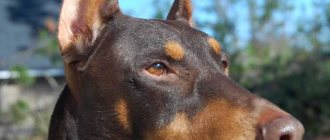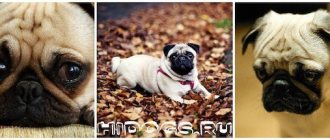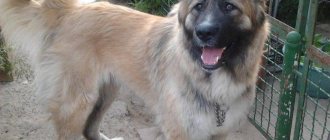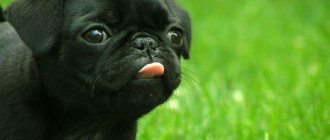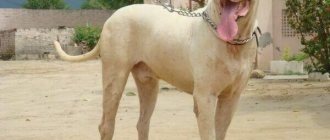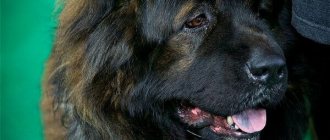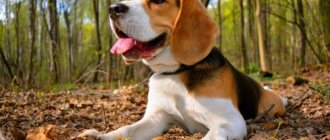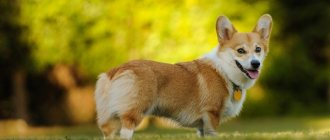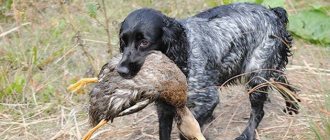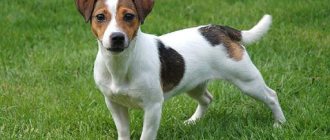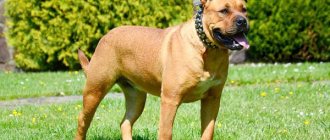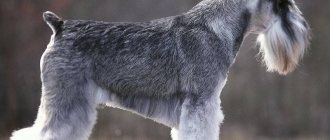Dog Samoyed Laika
The dog breed belongs to the ancient species, known for 3000 years.
The Samoyed Laika dog has been a reliable friend since ancient times, helping to herd herds of domestic animals, and taking an active part in hunting together with its owners. The first representatives of the species appeared in the Northern tribes who belonged to the Samoyed people. This is where the name of the breed comes from. In addition to hunting and shepherding, they were used as traction animals for sleds. Samoyed Laika dogs are considered excellent nannies. In northern tribes, pets were often left to look after children. In severe frosts, dogs were called to the tent so that children could sleep in an embrace, this helped to warm up and not freeze in too severe frosts. It is noteworthy that the dogs perfectly understood the assigned responsibility. During sleep, they froze and tried to move as little as possible so as not to cause inconvenience to their little sleeping owners.
The Samoyed is a beautiful dog with thick, white or cream-colored fur. Russia is considered the country of origin. Thick, warm wool helped people keep warm. When a person hugs a dog, the animal freezes and tries not to move so as not to disturb the owner.
Description of the breed
Description of the Samoyed Laika breed starts with the animal's fur. Main characteristics of the breed:
- Representatives of the species have double fur. The undercoat is dense and short. And the outer coat is hard, long and straight.
- Color – snow-white. Sometimes there are individuals that have a light cream tint, white with fawn shades - which is allowed by accepted canine standards.
- Wool style. According to accepted standards, the fur lies in a kind of collar located around the dog’s neck, a feature that is clearly expressed in males.
- The tail is fluffy.
The thick coat reliably protects the dog from bad weather. Considering that the tundra became the birthplace of the breed, Samoyeds are not afraid of even severe frosts. If the wool shows the correct structure, a special shine is characteristic. Has self-cleaning ability.
- The height of huskies does not exceed 60 cm. 54-60 cm for males and 50-56 cm for females is considered the norm.
- Weight varies from 17 to 25 kg for females, from 25 to 30 kg for males.
- The body is compact, powerful, elongated towards the neck.
- Nose is black. But during the year it changes color, forming a winter version. The edging of the nose always remains unchanged and is black.
Samoyed huskies are famous for their “talkativeness” and smile. The latter effect occurs due to the peculiar arrangement of the eyes and raised corners of the mouth. Unfortunately, the Samoyed Laika breed has a drawback: the animals simply cannot stand being alone. If you decide to get a dog of this breed, but are unable to ensure that the pet is not left alone, you will have to get the dog a partner. You don't have to choose a Samoyed; any breed will do.
Samoyeds are so resilient and strong that they are able to pull loads many times their own weight. The Samoyed Laika breed is not used as a guard dog - there are no suitable skills. Animals of the breed are friendly, have a cheerful disposition, and love children. Dogs are ideal for hunting. Not shy or aggressive.
Samoyed huskies have not been modified by breeders. The appearance and character are the merits of the dogs. The breed owes its name to the Samoyeds, a northern Nenets tribe. Nomads extremely valued huskies for their dedication and ability to perform high physical activity. Russia is recognized as the birthplace of the breed, but purebred breeding began in England. The state has adopted a standard that prescribes exclusively light colors for dogs, although initially dark shades of coat were found.
General characteristics of the Samoyed breed
The Samoyed is a medium-sized dog that can become not only a cheerful, playful pet, but also a loyal friend. From her ancestors - Arctic Spitz - she inherited an easy-going, affectionate character and a friendly attitude towards people. In ancient times, these dogs helped people survive, get food, protect them from predators, and even keep them warm in the cold. They are used to living next to a person, so they are very sad to be alone. A characteristic feature of these dogs is their thick white fur. Caring for her is not as difficult as it seems. It is easy to comb out, does not smell and is capable of self-cleaning. Samoyeds are very clean dogs; puppies usually get dirty. An adult dog will not get into the mud.
| Options | Characteristic |
| breed name | Samoyed Laika, Samoyed Spitz, Arctic Spitz, Samoyed, Sammy |
| country of origin | northern regions of Russia |
| group of breeds according to the ICF classification | Spitz, primitive breeds, northern sled dog section |
| application | hunter, sled dog, shepherd, guard, companion |
| life expectancy | 12-15 years |
| height | female 50-56 cm, male 54-60 cm |
| weight | female 17-25 kg, male 25-30 kg |
| attitude towards a person | non-aggressive, friendly, sociable |
| activity | very active, mobile |
| care features | complex grooming |
| training | uncomplicated, quick-witted, eager to serve people |
pros
It’s not for nothing that Samoyed huskies are among the top twenty most popular breeds. These cute, funny bears have many advantages.
- Developed instincts to serve people. This is not just a faithful companion, but also a guard, nanny, hunter, and sled dog. Even without special training, the dog will help the owner climb the mountain and carry a sled. Often used for canistherapy.
- The appearance is attractive: beautiful snow-white fur, slanting, intelligent eyes and a smiling, sharp muzzle.
- Samoyeds are very patient. They get along calmly with other pets and do not show aggression. They love children very much, forgive them all their pranks, protect and care for them.
- Sociable, cheerful, friendly to all people. Ready to constantly communicate with the owner, be nearby, and play. Very faithful, devoted, attached to one person.
- Their character is calm and flexible. Despite their activity and sociability, they are not intrusive and are quiet at home.
- The coat is easy to comb out and has no dog smell. If you collect fluff, you can knit socks and other warm clothes from it that provide good warmth.
- Samoyeds are unpretentious and tolerate cold weather well. This is a primitive breed, so the dogs inherited strong immunity from their ancestors.
Minuses
But the Samoyed cannot be called an ideal pet for keeping in a city apartment. These dogs have disadvantages that you also need to be aware of.
- Samoyeds are very fluffy. Many people find it difficult to care for their coat: they need to be brushed daily and sometimes cut.
- These dogs are talkative. They bark a lot, growl, howl, squeal, and like to make different sounds when communicating with a person.
- They are very good-natured and friendly towards all people, even strangers. Therefore, they cannot be defenders, and when protecting a house they simply inform the owner that someone has arrived.
- They do not tolerate loneliness well and can only be kept indoors.
- Not suitable for homebodies and inactive people. They require a lot of attention and serious physical activity.
An interesting video will tell you about the advantages and disadvantages of Samoyeds:
Common diseases
Samoyed huskies do not experience any health problems. This is a hardy and physically strong breed. Common diseases include:
- Diabetes;
- Bloating;
- Depigmentation of the nose;
- Arthritis;
- Urinary tract infections;
- Hip dysplasia.
Dogs of this breed exhibit increased sensitivity to selected analgesics. Rarely, congenital deafness and hereditary eye diseases occur.
Pet character
Intelligent and loyal to its owner, the Samoyed Laika demonstrates an independent disposition. It is unlikely that you will be able to achieve complete obedience from a dog. Occasionally exhibits strong stubbornness, but has never exhibited aggressive behavior. A long life side by side with people has endowed the dogs of the breed with incredible powers of observation. Dogs always understand a person’s requirements, which does not guarantee that their plans will be fulfilled.
Likes never attack first. They are quite capable of defending themselves, and in a fight they are an impressive opponent, even if they are fighting with a large dog or animal. Samoyed Laikas were often used as guards and taken for hunting. Representatives of the breed are tolerant of other pets. But the hunter's instinct can awaken in a dog at any time, as a result the dog will chase a cat or small animal.
Samoyeds always have a good relationship with children. For kids, however, huskies are too assertive. Representatives of the breed are noisy and playful and love to be in the center of events. The Samoyed Laika requires a lot of attention, which is important to consider when buying a puppy. Dogs quickly become attached to their owner. They are happy to accompany a person on trips and walks. Samoyeds easily adapt to new conditions.
If you don't pay attention to the representatives of the breed, the dogs will get bored. Pets are characterized by fear of separation from their owner. If huskies are left alone for a number of days, behavioral difficulties arise. Puppies need early socialization.
Education and training
Large and strong Samoyed dogs need decent upbringing. The education process begins from puppyhood. From the moment of the very first walk, it is necessary to patiently explain to the little Samoyed where it is necessary to go to the toilet. Naturally intelligent dogs understand quickly and by the age of three months they begin to ask to go outside on their own.
Contact and sociable representatives of the breed quickly adapt to a new place of residence, but react poorly to a change of owner. Samoyed training begins closer to six months of age, when the dog’s psyche is fully formed.
It should be noted that Samoyeds are an independent breed, endowed by nature with a sense of self-sufficiency and excessive pride. In general, shouting at dogs and using physical force is strictly prohibited .
You should build a relationship with a dog according to the principle of the existence of a wolf pack. The owner is the leader, the rest are subordinates. In case of total disobedience on the part of the dog, you should act like a she-wolf.
Confidently take the puppy by the withers, lift it off the ground, and shake it slightly. Then lightly press it to the floor, holding it until the puppy stops resisting. This is a rather offensive procedure for the dog, but effective, making it clear who is the leader in the pack.
The same technique can be used when practicing the “be silent” command, since it is very difficult to wean a Samoyed from barking. The breed is quite talkative, and barks at every opportunity, even if just to talk to its neighbors. And given their hearing acuity, dogs can talk to each other over very long distances.
Caring for the Samoyed Laika
Proper care of the Samoyed Laika means proper care for the animal’s thick and fluffy coat. Representatives of the breed have almost no characteristic dog smell. It is not recommended to wash the animal frequently. However, the fur absorbs the smell of other dogs. Then the husky will need to be bathed.
- It is enough to wash your dog 4 times a year.
A bath is quite suitable for water procedures. The dog is placed in a container so that its limbs are in the water. To wash the fur on the body, you will need to use a shower. The animal's fur is designed in such a way that it warms perfectly in cold weather, and in hot weather it reliably protects against overheating.
- After walks, be sure to wash the animal’s paws!
- In order for the husky's coat to look beautiful and quickly renew itself, the pet needs to be combed daily.
- It is recommended to carefully comb the fur behind the ears, where tangles often occur.
What to feed dogs
Each husky has its own tastes and preferences; there is no single recipe for feeding a pet. The question arises: what to feed the Samoyed Laika – dry food or products of natural origin? There is no definite answer; both options show advantages and disadvantages. Let's look at the benefits of feeding dry food:
- The product contains the necessary mineral supplements and nutritional elements. Balanced food does not dictate the condition of offering the dog additional vitamins.
- The method is much more convenient; you don’t have to prepare food for your pet.
- Many breeders prefer that Samoyed puppies become accustomed to dry food from an early age. As a rule, the decision is motivated by the knowledge that dozens of generations of dogs have grown up on dry food.
The disadvantages of dry food include the possibility of purchasing an unworthy product. It is recommended to choose only time-tested brands made by well-known manufacturers. Keep in mind that when choosing dry food you will have to change several brands - dogs have their own taste.
If we talk about nutrition based on the use of natural products, the advantages are:
- Accurate knowledge of food preparation technology and recipes.
- The dog's menu is more varied than the constant food offered to the animal every day.
- Additional vitamins and microelements can be purchased at a veterinary pharmacy and added to food.
The result is a varied, vitamin- and mineral-rich meal made from high-quality ingredients. The downside of the diet is that it takes a lot of time to prepare food.
When thinking about what to feed Samoyed husky puppies, remember that babies are taught to feed according to a schedule and to a certain amount of food in a bowl.
Training and tips
The Samoyed Laika dog breed is a playful and affectionate animal, they adore children and love to play active games with a ball or tug-of-war. Representatives of the breed are curious, eager to try a lot to their teeth.
Samoyed husky training includes teaching basic commands. The pet must clearly understand the boundaries of what is permitted. The dog is also obliged to strictly obey its owner, especially on the street.
Laikas of this type are cunning creatures and intelligent. They assess the situation and the owner’s mood with lightning speed and behave accordingly. Representatives of the breed will never obey a person 100% due to their natural independent nature, they should always remain alert.
Origin of the breed and its names
These dogs belong to the northern breeds, which is easy to guess from their thick and long hair. There is evidence that they accompanied people in the Far North three thousand years ago. Moreover, all this time they were not subjected to directed selection and owe their advantages only to nature. The Samoyed Laika got its name from the name of the tribe from which the Europeans “borrowed” the dog. The people were called “Saam-Ende”, which to the Russian ear sounded like “Samoyeds”. The British brought the breed to the West - exactly which breed and at what time has not been established; there are different versions. But Great Britain was captivated by the beauty, endurance and intelligence of the Samoyeds. From there this breed began to spread throughout the world.
Advantages and disadvantages of the breed
Intelligent and resourceful by nature, Samoyeds are able to read the intentions and even thoughts of their owner. They use their abilities, causing the owner a lot of trouble in childhood.
But if you don’t stop their pranks, you can spoil the dog, for example, by taking countermeasures to punish for eating slippers in the form of a folded newspaper on the nose. It doesn’t hurt, but it hurts, and the dog understands everything , smiling back.
The muzzle expresses the whole range of emotions, forcing the owner to dance to his tune. The main thing is not to fall for psychological tricks and nets, which the dog knows how to masterfully place for his own benefit.
This is the breed of dog that, after receiving a command, thinks about it and calculates the amount of benefit received if it is executed. There is no doubt that the Samoyed will comply with the command. He will do everything to please his owner. But the expression on the face is a separate matter.
The diet of the Samoyed also deserves a separate discussion. This is the weakest link, since great love leads to negative consequences. To please the most beloved Samoyed, the owners commit a crime by treating them to something tasty. This is detrimental to health, shortening the pet’s life.
Breed standards
No one carried out any purposeful consolidation of certain breed characteristics. Yes, there should be no need for this. Samoyeds are distinguished by their distinct appearance, and culling of the breed based on color or constitution practically does not occur. It is always clear from the appearance of the dog that this is a Samoyed husky. It is not difficult to describe the breed: an animal of medium size, powerful, almost square in build, with a wide chest and a strong neck. The tail is a “donut”, curved over the back or side. In height, males reach 61 centimeters (but not less than 53), females - from 48 to 53. Weight ranges between 20 and 27 kilograms. The color is predominantly white; a cream shade or a combination of both is possible. The nose is brown, black or sandy; It is interesting that its shade can change depending on age and weather. A distinctive feature, very attractive in the case of urban, apartment living, is that the Samoyed Laika has no smell. Of course, wool can absorb foreign “odors”, but it doesn’t smell like a dog from an animal only if there is another dog in the house, of a different breed.
Samoyed diseases
Thanks to human non-interference, the Samoyed Laika breed is distinguished by enviable health. Minor problems like age-related depigmentation of the nose are not even considered a defect; Occasional bloating does not require special treatment. Occasionally, puppies with congenital deafness or hip dysplasia may be born in a litter; breeders discard them immediately. Serious diseases include diabetes and eye problems (progressive retinal atrophy, cataracts and glaucoma), but again they are quite rare. Obesity, which affects many artificially bred breeds, was not observed in Samoyeds even with systematic overfeeding. Accordingly, they do not have concomitant heart diseases.
Reviews
Varfolomeeva:
As a breeder, I note that Samoyeds are not huskies! Apart from the curled tail, nothing else connects these two breeds. There is nothing in common between them.
Lena:
I don't know how I lived without a dog before. During the 8 months of this cool creature’s presence in our home, our whole life simply turned upside down, and for the better. A cheerful and mischievous boy. I don’t know about others, but ours is very obedient. Probably the fastest specimen to learn commands was caught.
Galina Petrovna:
The love for children and peaceful nature towards other dogs, cats, and even turtles is striking. But he gnaws everything that comes into contact with his teeth.
Tatiana:
We got a dog a year ago. The joyful euphoria continued until the molt. One fine morning we woke up with an abundance of hair in our nose, throat, dishes - everywhere. My advice to anyone who will adopt a dog is to listen carefully to what the breeder is saying and don’t be like our family.
Ksenia:
The dog is simply gorgeous, but the process of combing can easily be attributed to the shortcomings of the breed. Although I myself have two Samoyeds, I wouldn’t mind getting a third one.
We invite you to talk about the most charming and playful, touching and sensible representatives of the beautiful Arctic breed of Samoyed dogs. We'd love to hear your stories about pets. We are discussing solutions to problems with education and how much a Samoyed Laika costs today. It is fashionable to leave your comments at the bottom of the article.
Share
Leave a review
Character traits
For a person who needs a guard dog, a Samoyed husky is absolutely not suitable. These dogs are very friendly and non-aggressive; distrust and wariness are not inherent in their character. They can be trained, but remain smart and cunning animals: in any situation they instantly assess the situation and the seriousness of your intentions. Having given the Samoyed some relief, next time it will be very difficult to insist on fulfilling the “conditions of coexistence.”
These dogs are playful and good with children, even the smallest ones. We can say that the Samoyed Laika (photos are presented in the article) is an ideal companion. However, it also has its drawbacks. First of all, it is difficult for her to learn to ask to go to the toilet. Yet her ancestors lived on the street. The second drawback: due to their affection, Samoyeds categorically cannot stand loneliness. Moreover, they express their protest actively: they can howl and bark for hours, chew furniture and shoes, even knowing that this is prohibited. Therefore, if you, like most people, go to work and there is no one left in the house except the Samoyed, you will have to take care of company for him. Since dogs are very warm towards other animals, even a cat will do.
Samoyed Laika (Samoyed) - owner reviews
Negative review
Advantages:
Beautiful appearance and no smell.
Flaws:
I described everything point by point in the text. I advise beginners to read and think about it.
This miracle has been living in our house for three years now. Samoyed Dog. It’s not my first, I have a good and positive experience behind me. We also have a Corgi, an extraordinary dog with the kindest and most loyal heart. Before that, there was also a dog who lived with us for a decent 15 years. And to say that I love dogs is an understatement. I've always simply adored them. We took our Samoyed for an active lifestyle, we planned to ride bicycles, ski with it, etc. We bought it from prof. nursery. Quite famous among Samoyed owners. Parents are super champions. We were predicted to have a wonderful exhibition career. And maybe it would have turned out that way, but we were unlucky with our character. I also had to forget about sports. Obviously, the dog was not intended for its purpose. Terribly lazy))) And sometimes just uncontrollable! How much money, time and effort we spent to at least somehow correct her behavior! What nerves this was all worth! OKD passed with grief in half. We turned to recommended and already familiar dog handlers, animal psychologists, etc. etc. And we just realized that it couldn’t be fixed. ))) We will love you as you are. Among the owners of Samoyeds I found excellent friends with whom we constantly meet, organize hikes or just walks, share experiences, as well as problems in education. I came to the conclusion that we are not the only ones. And there are very, very many people like us. Samoyeds really have a lot of behavioral problems and here are some of them: 1. There is too much of her! Energy like a vampire. ))) Samoyeds are very jealous and demand maximum attention. All your 24 hours. We also have animals at home. A cat and a dog of the Welsh Corgi breed. They are all young and full of energy, but they always have their own things to do. With the Samoyed, it turned out that she was not interested in playing with other animals. She constantly needs to hang on to her owners. They should and simply must play with her around the clock until she gets tired, but she never gets tired of playing games. The whole world should revolve around her. The first year it seemed to me that I didn’t have a puppy at home, but an infant who was not growing up. If ignored, the dog falls into either frantic hysteria or aggressive depression. She can lie all day, eat nothing and doesn’t let anyone near her, growls, mischiefs, barks... And all this will happen until they come up to Her Majesty and start persuading her to eat, play, etc.))) 2. The dog often runs away, loves everyone and everyone, recognizes the owner in anyone who feeds him deliciously. They love to hug and tease everything that moves, including a Kamaz truck, even if it is traveling at a speed of 100 km/h. It’s okay, you won’t have time to blink an eye and throw yourself under the wheels. Unfortunately, in three years we have already heard a lot about how Samoyed escapes end. So, the experienced ones try not to let them off the leash. 3. They love to yap. Very loud and shrill. Ours loves to scream during ultrasound, so much so that her ears get blocked. However, like many Samoyed girls. 4. Trusting and loving. They are absolutely not loyal to their master. If you leave your Samoyed with a stranger and you go on vacation for 2 weeks, then he is unlikely to miss you. We leave ours to friends who have 2 Samoyeds. It was as if we didn’t exist... Although, of course, there are loyal dogs among Samoyeds, but this is rather an exception. 5. They are difficult to train. There is rather a misconception here. Samoyeds understand human speech very well. Personally, my dog understands everything! But she will never just do what she is told. You definitely need a motivator. This is not a corgi or a shepherd dog, which will stand on its hind legs only out of loyalty. He behaves disgracefully on the street. All classes, as I understand it, are just passing by. There are bananas in the ears, the tongue is over the shoulder and just wildly jumps from side to side. She flatly refuses to play with me and the second dog. We just go out into the street and she runs around chaotically. ))) bullies the elder, who barks at her menacingly, but the house is friendly and they play quite well, if, of course, the queen deigns. )) 6. Well, perhaps the worst thing for me is dirt and fluff. They shed shamelessly. Even on expensive vitamins and good food, we have fur everywhere. Now I can’t do without cleaning every day. He eats all over the house, very sloppy. If our Corgi eats at the bowl, then the Samoyed will carry pieces of meat throughout the house, play with them, poke around, be greedy, and growl at everyone. We worked on this “growl” on trust for a very long time. In general, a complete zero.))) And if they gave you a bone, then it’s scary to go into the room where it’s located, not only will it not let anyone near it, it won’t let anyone into the room. Although I take everything from Corgi calmly. Never growls. But this is a completely separate topic. And now I get to the important thing. I sometimes perceive everything that I described above with a smile. Everyone has their own character, nervous system, etc. But Samoyeds have one huge drawback; maybe, of course, this also exists in other breeds, but I haven’t heard... They are vindictive and will definitely take revenge for punishment, even if it was fair . Mine takes revenge on me in the following way: she pees or makes piles on my bed... Exactly in the place where I sleep. By the way, I'm not the first. I often observe this phenomenon on forums or social groups. networks. A friend’s dog has been peeing on her carpet next to her bed or on her things for about five years now... But beds and sofas are priority places for some reason. Honestly, I’ve never even had cats like these... And in terms of toilet training, these are the stupidest dogs I’ve ever known. I trained my corgi to walk for exactly a week. Then he began to ask himself. The Samoyed dog was trained before she was a year old. And it's very hard. And even now she never asks, I just take them out for a walk at a certain time, apparently she’s gotten used to the routine. Some people treat this normally and patiently, saying the hackneyed phrase “it’s a Samoyed.” I come to the conclusion that a more useless and stupid breed simply does not exist. Disadvantages: they are clearly overstretched, and sometimes they go off scale. There is, of course, a huge plus - the breed is gorgeous in appearance. But for aesthetic pleasure, it’s better to get a Pomeranian; at least he won’t sprain his fingers while walking. Yes! And this happened to us. I decided for myself that I would never again get involved with the Samoyed Dog breed. Still, a dog is a faithful friend, a companion, sometimes a watchman, sometimes a nanny. Who will love you. But not the other way around.
Contents of the Samoyed Laika
Samoyeds do not require any special conditions. The most comfortable life for them will still be in a country house, and definitely not on a chain - the dog is a freedom-loving dog. However, if there is a not lazy owner, the Samoyed Laika feels excellent in urban conditions - two long walks a day completely satisfy its need for movement. Extra weekend trips to nature or longer trips to a nearby park will keep the Samoyed in good shape. It is advisable to walk your pet on a long, adjustable leash - urban conditions can be dangerous for a friendly and active dog.
The Samoyed Laika (the photos allow you to get an idea of these beauties) is also not too troublesome to care for, except for the fur. You need to brush your dog regularly, preferably daily, especially during the shedding period. The areas that are most thoroughly treated are the armpits, under the lower jaw and behind the ears - tangles most often form there. But you don’t need to bathe the Samoyed often - you can disrupt the repellency of the coat. The animal is washed no more than four times a year and mainly to get rid of foreign odors.
Since the breed is as close as possible to its wild relatives, there are no diets or prohibitions on certain foods for Samoyeds. What exactly to feed the pet is up to the owner to decide for himself. However, at the very beginning, you need to ask the breeder what the Samoyed husky puppy ate before it fell into your hands. If you have other preferences in this regard, you will have to switch to a new diet gradually so as not to provoke stomach problems.
We should also talk about at what age you should switch from puppy food to adult food. There is evidence that prolonged feeding with baby food increases the likelihood of developing dysplasia; as already mentioned, the Samoyed Laika is prone to it.
From the moment the puppy enters your home, you need to accustom him to feeding at the allotted time and to putting a strictly defined amount of food in his bowl.
One more nuance: the Samoyed husky loves fish, which surprises many. Meanwhile, there is nothing to be surprised here. Remember where this breed comes from: fish has been its natural diet for many centuries. In current conditions, such a product can even be used as a treat for reward.
Choosing a puppy
You should consider some tips that will become indispensable when choosing a companion for a period of 12-15 years.
- The selection of a puppy takes place on his 45th birthday and not earlier! In this case, it is necessary to wash your hands thoroughly, because the baby has not yet been vaccinated. It is also important to pay attention to the condition of the house: the apartment should be clean, without foreign odors of urine or feces. This shows the attitude of the owners not only towards the dog, but also towards its puppies.
- A puppy 45 days or older must be clean, well-groomed and smelling good. The eyes should not contain pus or other discharge, the puppy’s ears should also be clean and not contain dirt or lumps of wax.
- A small Samoyed must have the correct bite and the required number of incisors. At this age, lip pigmentation may be intermittent, but it is necessary to pay attention to the presence of blackheads. They indicate complete further pigmentation.
- Umbilical hernia. It may be present in the puppy, but only in a small amount. If a hernia occurs, the operation to remove it must be financed by the breeder. A puppy with a pedigree is sold in full accordance with the breed standard!
- You should pay attention to the movement of the puppy. The front paws should be positioned strictly parallel to each other, and the elbows should be pressed to the ribs.
- Tail position. By the age of 1.5 months, he should already be in his position. It is best when the tail is adjacent to the body, and does not hang over one side.
- Prevention against worms. It is necessary to check with the breeder when the worms were removed and with what drugs. The mandatory period is 21 days and then every 10 days until the puppy is 2 months old.
This breed is distinguished by its devotion to its owners, so it is not advisable to adopt a dog as an adult , since it is devoted to only one! Having adopted a puppy, he will never betray you.
No special preparation is required in the home before the arrival of a Samoyed puppy. The main thing, as with other breeds, is to remove valuable and fragile things from visibility . Puppies are too active and may touch some objects while playing.
Price of puppies
The average cost of pedigree puppies ranges from $250 to $1,000 . Several factors influence the cost:
- Gender of the puppy;
- The eminence of the ancestors;
- Purpose of purchasing a dog.
Females usually cost more than males. Moreover, if the puppies’ parents have honorary titles, then their value increases accordingly.
If a puppy is purchased as a pet, then it may have some minor flaws that are important for show animals, so its cost may vary significantly.
Puppies without documents will cost 1.5 - 2 times cheaper.
Origin story
The Samoyed Laika is one of the oldest Spitz-type breeds. Why they called it this way becomes clear as soon as you become more familiar with the peculiarities of the appearance of the breed. The animals owe their name to the northern aborigines Samoyeds, who inhabited the expanses of the Urals and Siberia. The Samoyeds were nomads; they needed loyal and hardy helpers. This is how the huskies became, from which they became excellent shepherds, excellent hunters and irreplaceable caretakers of children.
After zoologist Ernst Kilburn-Scott came north with an expedition and fell in love with an unusual shaggy dog, it ended up in England, since the traveler took several individuals with him on the way back. The scientist became seriously interested in breeding the breed. He can boast that he organized the first nursery.
The breed standard was established in 1909.
Purpose of the view
Since the very first mentions of the amazing breed of northern dogs, the dogs’ abilities as sled dogs have been noted. A team of several Samoyeds could tirelessly drag a loaded sleigh over very long distances. They were not bothered by the absence of a driver. Intelligent dogs knew the route perfectly well and delivered the goods to their destination on time.
Samoyeds have proven themselves to be excellent companion dogs. They are always on the alert and are able to provide timely assistance to the hunter. In addition, the Samoyed dog is an excellent watchman, but not a security guard, since the Samoyed is of medium size and will never bite a person - it is completely devoid of aggression. But smiling warriors are wonderful companions, ready to serve people faithfully.
A large number of names of Arctic dogs with a long history may not seem strange. Since ancient times, the Nenets called them voinaikas - omniscient watchmen. By analogy with consonances in Slavic pronunciation, the word sounded like huskies. In this form, the name was assigned to dogs, although this is incorrect.
The Nenets nomads were also called differently - Samoyeds. Purchasing his first puppies from nomads, the same Kilburn-Scott, representing them in Europe, gave them the name Samoyed dogs - that’s why the breed of these amazing canines is still called that way.
Description of the breed
The Samoyed with its beautiful coat stands out among other breeds. The good-natured face is decorated with a sincere smile, and wisdom is hidden in the eyes. The Samoyed Laika has a certain standard. The dimensions of an adult individual consist of the following parameters: height - 46-56 cm (females are shorter than males), weight about 20-30 kg.
The breed is usually represented by two types:
- Bear type. Recognized by its strong body and large head.
- Wolf type. A lean physique, a chest of medium width and a slightly elongated head, reminiscent of a wedge in shape.
Care and maintenance
The maintenance and care of huskies of this species must be carried out especially carefully. It is better, of course, to keep such a pet outside the city, in a private house. However, the dog will also feel good in the apartment, but provided that it is provided with regular and long walks. Laikas are clean animals. But their thick coat requires systematic care, especially during shedding, which occurs once every six months.
Every week the dog needs to be brushed using a special slicker. During the molting period, this procedure should be increased to 3-4 times weekly. You need to measure your pet's body temperature regularly. A simple thermometer is suitable for these purposes. It is enough to bathe 3-4 times a year. If you wash your dog more often, there is a high risk of significantly worsening the condition of the coat.
If you are not sure that the owner can create the optimal diet for his purebred pet, then it is better to consult a veterinarian. According to some experts, huskies should be fed with specialized food. Both dry and wet are suitable. This is a way in which your pet is guaranteed to receive all the vitamins and mineral complexes he requires.
When planning feeding using natural products, you must ensure that the diet does not contain chocolate, chicken and pork bones, eggs, or raw meat. To eliminate the possibility of developing problems with the gastrointestinal tract, it is advisable to feed the dog after completing a walk. If the dog gets enough physical exercise, they will not be afraid of the problem of excess weight.
Minuses
The disadvantages include the following points:
- Samoyeds are very stubborn . This is a very smart dog, so it always puts its own decisions above the demands of its owner. Representatives of the breed do not like to obey at all.
- They are difficult to train . Samoyeds can only be trained when they are puppies. In the future, it will be very difficult to instill any commands in the dog. If the Samoyed puppy does not want to carry out this or that command, then most likely, further training will be useless.
- Samoyeds shed . Beautiful, luxurious wool tends to fall out regularly. Laikas typically shed twice a year.
- If a Samoyed is bored, it may begin to howl . A dog does not bark or howl only if it is provided with optimal care, namely, adequate feeding and regular exercise. Otherwise, the entire house will hear your pet's howl.
- Price . A purebred animal is not a cheap pleasure. Thus, the cost of a husky with a good pedigree reaches up to 100 thousand rubles .
Training and education
The educational process of the Samoyed husky consists of a system of development and consolidation of already formed skills with the help of encouragement and coercion. In this process, all necessary commands are trained. Execution of commands is an important condition. If a puppy regularly refuses to listen to its owner, then constant disobedience should be expected from it in the future.
Competent education necessarily contains elements of punishment. The main thing is to carry them out in a timely manner.
You won't be able to get an obedient pet without training. To achieve the desired result, it is better to rarely resort to a system of physical punishment. The structure of training is equated to the principles of a wolf pack. So, the leader or owner always does everything first. For example, the whole family has eaten, only after that can you feed the dog. It is recommended to start training the Samoyed husky from 3 months of age.
It is better to entrust the training of your pet to a specialist if the owner of the husky is new to this matter. An experienced instructor will be able to find an approach to any pet; the educational process will be easy and relaxed.
Diseases and life expectancy
Samoyeds, like true northerners, are distinguished by endurance, strength and hardening. Their health is good, since the strength of their immunity can only be envied. But certain risks still exist. Dogs can get sick:
- dysplasia of the hip or elbow joints, manifested by stiffness of movement and lameness;
- arthritis;
- pathologies of the cardiovascular system;
- eye diseases (cataracts, glaucoma);
- diabetes;
- there may be a volvulus.
The quality and life expectancy of the Samoyed Laika depends on what living conditions and care were provided to it. On average, individuals of this breed live 12-15 years.
Samoyed Laika Standards
The general information is as follows:
- height at withers: 50 - 60 cm;
- the weight of an adult reaches 23 - 30 kg;
- The average life expectancy is 12-15 years.
Let us describe the representative of the breed in more detail:
- The head is powerful, large and wedge-shaped. The ears are erect, small, thick, triangular and slightly rounded at the tips. Set wide apart and very sensitive. The eyes are dark brown, deep and wide, slightly slanted, almond-shaped. The nose is well developed and mostly black. The teeth, jaws and cheekbones are strong and form a perfect scissor bite.
- The body is strong, muscular, compact and flexible. The tail is set high and bushy. When the dog is emotionally excited, it bends onto its back and side.
- Limbs. The front and hind legs are well spaced, strong, muscular, straight and parallel.
- Coat:
- color: white, cream or white with beige,
- coat: thick, dense. There is a soft and dense undercoat and a “mane” around the neck and shoulders.
Samoyed Laika Standards
